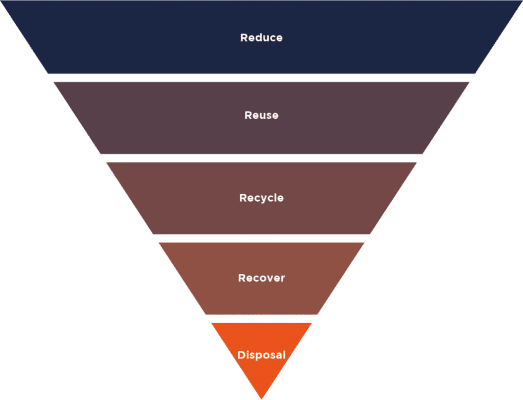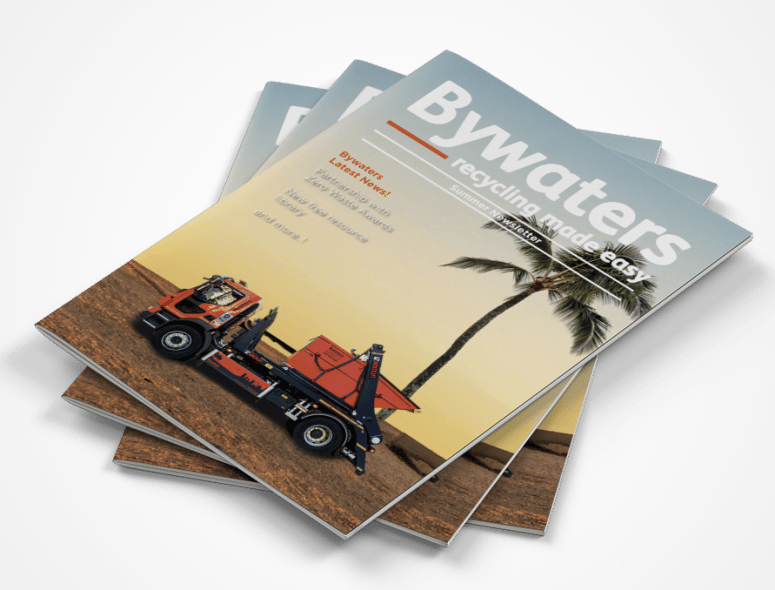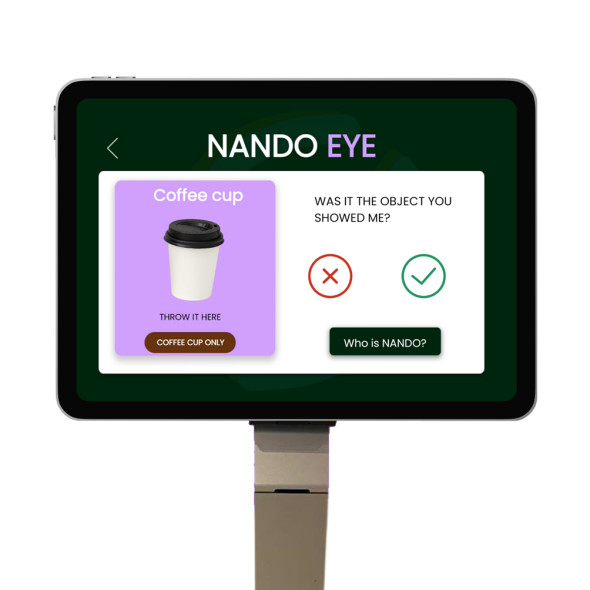Contact us today for your Free Quote
Recycle, Incinerate, Upcycle, Reuse – there are so many terms used when disposing of waste that it’s difficult to know what to do. Luckily for you, there is an easy tool to ensure you’re as sustainable as possible – The Waste Hierarchy.
Confusion surrounding waste disposal can be the biggest cause of incorrect disposal and contamination. However, we’re here to help, we’ve put together a detailed overview of the waste hierarchy and how it can help you improve your sustainability!
But what is the waste hierarchy?
Designed in 1975, the waste hierarchy was introduced in the European Waste Directive to emphasise the importance of waste minimisation and the protection of the environment and human health. By introducing a five tiered funnel – to be applied in any situation where a product will be disposed of – its aim is to reduce waste, preserve valuable resources, and reduce your environmental impact.
There are loads of variations to the waste hierarchy, however they all follow the same pattern. At Bywaters, we recommend using the below diagram when disposing of anything:
 |
But what does it mean?
Well, for you keen recyclers out there, just recycling won’t be enough! We have broken down each section of the hierarchy to help you understand the impact of your actions, and how you can apply each tier effectively.
Reduce
It might seem obvious, but before even thinking about disposing of waste, you need to ask yourself, “did I even need to produce it?” By reducing consumption in the first instance, no waste will be produced. Take the fashion industry, for example, it now accounts for a full 10% of humanity’s total carbon emissions – more than all international flights and maritime shipping activities combined. Fast fashion has people buying and throwing away more clothes than ever before. But, is this really necessary?
“Throwaway culture” is embedded in society. As explained in our sustainable consumption blog. Whether through lack of knowledge or lack of accountability, this has been ingrained in society as we know it. However, there does seem to be a conscious shift in consumer behaviour, and brands have taken notice. Take Tescos, for example, they recently banned all beer and cider with plastic rings and shrink wrap from their shelves, a movement being replicated across industries in the UK.
Reuse
I know it seems simple, but do you ask yourself if something can be reused every time you throw it away? There are countless opportunities to reuse everyday items, whether personally or through the many local and online communities, such as; Freecycle, Facebook Marketplace and Vinted – where your throw away clothing is someone else’s retro bargain.
At Bywaters, we prioritise our reuse service over recycling and energy recovery to make sure products are used again and again until they reach the end of their lives. We work with our clients to find new and exciting ways to reduce waste, reusing good quality items destined for the bin. Working with our reuse partner Reyooz, we have found new homes for; Bikes, Computers, Office furniture and even a security hut!
Recycle
With the emphasis on recycling, it might seem odd that it is this low down on The Waste Hierarchy, however it makes complete sense when you think about it. Although not as sustainable as reducing or reusing, recycling is of vital importance to circular initiatives and resource preservation. For example, it takes 75% less energy to make a plastic bottle from recycled than virgin material and 95% less for aluminium.
Our recycling service takes energy preservation even further in the segregation of materials. Using sustainable energy from 4000 solar panels installed on our roof we have managed to reduce associated carbon emissions by around 45%, producing enough power to run 237 homes for a year. Making our recycling service one of the most sustainable around.
Recover
Now we get down to the seemingly dirty section of the waste hierarchy. However, it carries fundamental importance in the fight against climate change. Waste recovery – be it through Incineration with energy recovery, RDF or any other form – helps divert waste from landfill, not only saving land space but also reducing harmful greenhouse gas emissions.
The biggest benefit of recovery solutions is the energy generated through the process. Where landfilled items are left to decay – plastics can take up 1000 years to decompose in landfill – recovery processes generate energy used to power the national grid. However, these solutions do destroy valuable resources, many of which are finite. So, where possible waste should be recycled or reused.
Disposal
Finally, we come to disposal – when all other avenues are exhausted, waste will need to be disposed of. This will generally be in a landfill site. Instead of going into detail, we have included some facts about landfill in the UK to demonstrate why this should be seen as a last resort:
- Every year we send over 15 million tonnes of rubbish to landfill across the UK.
- Methane emissions from landfills in 2019 were equivalent to the greenhouse gas emissions from more than 21.6 million passenger vehicles driven for one year or the CO2 emissions from nearly 12.0 million homes’ energy use for one year.
- Methane is 28 to 36 times more effective than CO2 at trapping heat in the atmosphere over a 100-year period.
At Bywaters, we strive to provide all of our clients with Zero waste to landfill solutions, finding options to move waste up The HIerarchy where possible.
Get in touch
So, now you know what the waste hierarchy is and how it should be used, you’re ready to make a difference. But, if you need some help applying the practices to your business, we’re always here – just get in touch to see how Bywaters can help you.


